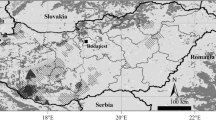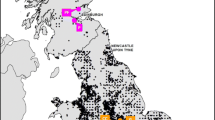Abstract
Background
The Korean Peninsula is a small but unique area showing great endemic Hynobius diversity with H. quelpaertensis, H. yangi, H. unisacculus and three species candidates (HC1, HC3 and HC4). H. quelpaertensis is distributed in the southern part and in Jeju Island, while the remaining species have extremely narrow distributions.
Objectives
To examine the genetic structure of H. quelpaertensis and the phylogenetic placement in Hynobius.
Methods
Three mitochondrial and six microsatellite loci were genotyped for 204 Hynobius quelpaertensis, three H. leechii, three H. yangi, three HC1, two H. unisacculus, three HC3, three HC4 and ten Japanses H. lichenatus.
Results
A high level of mitochondrial diversity was found in H. quelpaertensis. Our mitochondrial data showed evidence of a historical link between inland and Jeju Island despite the signature of founder effect likely experienced by the early island populations. However, our microsatellite analysis showed the fairly clear signature of isolation history between in- and island populations. Upon phylogenetic analysis, H. quelpaertensis, H. unisacculus and HC1 formed a cluster, whereas H. yangi belonged to a separate cluster. HC3 and HC4 were clustered with either H. quelpaertensis or H. yangi depending on the locus used.
Conclusion
Our results show at least partially the historical imprints engraved by dispersal of Korean endemic Hynobius during Pleistocene, potentially providing a fundamental basis in determining the conservation units and finding management strategies for these species.

http://widemaphst.cafe24.com/wmap/html/kbma4_down.html and https://rgm-79.tistory.com/703 (both were freely available for non-commercial purposes) (color figure online)





Similar content being viewed by others
References
Baek HJ, Lee MY, Lee H, Min MS (2011a) Mitochondrial DNA data unveil highly divergent populations within the genus Hynobius (Caudata: Hynobiidae) in South Korea. Mol Cells 31(2):105–112
Baek HJ, Song JY, Lee H, Min MS (2011b) Species identification of a new candidate taxon HC2 (Caudata: Hynobiidae) using mitochondrial CO1 gene. Korean J Herpetol 3(1):25–32
Choi SK, Lee JE, Kim YJ, Min MS, Voloshina I, Myslenkov A, Oh JG, Kim TH, Markov N, Seryodkin I, Ishiguro N, Yu L, Zhang YP, Lee H, Kim KS (2014) Genetic structure of wild boar (Sus scrofa) populations from East Asia based on microsatellite loci analyses. BMC Genet 15:85
d’Alpoim Guedes J, Austermann J, Mitrovica JX (2016) Lost foraging opportunities for East Asian hunter-gatherers due to rising sea level since the last glacial maximum. Geoarchaeology 31(4):255–266
Drummond AJ, Suchard MA, Xie D, Rambaut A (2012) Bayesian phylogenetics with BEAUti and the BEAST 1.7. Mol Biol Evol 29(8):1969–1973
Earl DA, vonHoldt BM (2012) STRUCTURE HARVESTER: a website and program for visualizing STRUCTURE output and implementing the Evanno method. Conserv Genet Resour 4(2):359–361
Evanno G, Regnaut S, Goudet J (2005) Detecting the number of clusters of individuals using the software STRUCTURE: a simulation study. Mol Ecol 14(8):2611–2620
Fouquet A, Vences M, Salducci MD, Meyer A, Marty C, Blanc M, Gilles A (2007) Revealing cryptic diversity using molecular phylogenetics and phylogeography in frogs of the Scinax ruber and Rhinella margaritifera species groups. Mol Phylogenet Evol 43(2):567–582
Fu Y (1997) Statistical tests of neutrality of mutations against population growth, hitchhiking and background selection. Genetics 147(2):915–925
Goudet J (2001) FSTAT, a program to estimate and test gene diversity and fixation indices (version 2.9.3). http://www2.unil.ch/popgen/softwares/fstat.htm. Accessed May 2019
Greenan TM, Griffiths CL, Santamaria CA (2018) Molecular approaches uncover cryptic diversity in intertidal Ligia isopods (Crustacea, Isopoda, Ligiidae) across the southern Africa coastline. PeerJ 6:e4658
Guo SW, Thompson EA (1992) Performing the exact test of Hardy–Weinberg proportion for multiple alleles. Biometrics 48(2):361–372
Hamilton MB, Pincus EL, Di Fiore A, Fleischer RC (1999) Universal linker and ligation procedures for construction of genomic DNA libraries enriched for microsatellites. Biotechniques 27(3):500–507
Helms BS, Vaught RC, Suciu SK (2015) Cryptic diversity within two endemic crayfish species of the Southeastern US revealed by molecular genetics and geometric morphometrics. Hydrobiologia 755(1):283–298
Hewitt GM (2004) Genetic consequences of climatic oscillations in the Quaternary. Philos Trans R Soc B 359(1442):183–195
Hoarau G, Coyer JA, Veldsink JH, Stam WT, Olsen JL (2007) Glacial refugia and recolonization pathways in the brown seaweed Fucus serratus. Mol Ecol 16(17):3606–3616
Jo Y, Kim T, Choi B, Oh H (2012) Current status of terrestrial mammals on Jeju Island. J Species Res 1(2):249–256
Kalyaanamoorthy S, Minh BQ, Wong TKF, von Haeseler A, Jermiin LS (2017) ModelFinder: fast model selection for accurate phylogenetic estimates. Nat Methods 14(6):587–589
Kim JB, Min MS, Matsui M (2003) A new species of lentic breeding Korean salamander of the genus Hynobius (Amphibia, Urodela). Zool Sci 20(9):1163–1169
Larkin MA, Blackshields G, Brown NP, Chenna R, McGettigan PA, McWilliam H, Valentin F, Wallace IM, Wilm A, Lopez R, Thompson JD, Gibson TJ, Higgins DG (2007) Clustal W and Clustal X version 2.0. Bioinformatics 23(21):2947–2948
Lee YS, Markov N, Voloshina I, Argunov A, Bayarlkhagva D, Oh JG, Park YS, Min MS, Lee H, Kim KS (2015) Genetic diversity and genetic structure of the Siberian roe deer (Capreolus pygargus) populations from Asia. BMC Genet 16:100
Leigh JW, Bryant D (2015) PopART: full-feature software for haplotype network construction. Methods Ecol Evol 6(9):1110–1116
Librado P, Rozas J (2009) DnaSP v5: a software for comprehensive analysis of DNA polymorphism data. Bioinformatics 25(11):1451–1452
Luikart G, Allendorf F, Cornuet J, Sherwin W (1998) Distortion of allele frequency distributions provides a test for recent population bottlenecks. J Hered 89(3):238–247
Min MS, Baek HJ, Song JY, Chang MH, Poyarkov NA Jr (2016) A new species of salamander of the genus Hynobius (Amphibia, Caudata, Hynobiidae) from South Korea. Zootaxa 4169(3):475–503
Monsen KJ, Blouin MS (2003) Genetic structure in a montane ranid frog: restricted gene flow and nuclear-mitochondrial discordance. Mol Ecol 12(12):3275–3286
Nei M (1987) Molecular evolutionary genetics. Columbia University Press, New York
Nguyen LT, Schmidt HA, von Haeseler A, Minh BQ (2015) IQ-TREE: a fast and effective stochastic algorithm for estimating maximum-likelihood phylogenies. Mol Biol Evol 32(1):268–274
Oh DJ, Chang MH, Oh HS, Jung YH (2007) The complete mitochondrial DNA sequence of the Jeju salamander, Hynobius quelpaertensis, and the phylogenetic relationships among the Hynobiidae. Korean J Genet 29(3):331–341
Oliver PM, Adams M, Lee MS, Hutchinson MN, Doughty P (2009) Cryptic diversity in vertebrates: molecular data double estimates of species diversity in a radiation of Australian lizards (Diplodactylus, Gekkota). Proc Biol Sci 276(1664):2001–2007
Piry S, Luikart G, Cornuet J (1999) BOTTLENECK: a computer program for detecting recent reductions in the effective population size using allele frequency data. J Hered 90(4):502–503
Pritchard JK, Stephens M, Donnelly P (2000) Inference of population structure using multilocus genotype data. Genetics 155(2):945–959
Provan J, Bennett KD (2008) Phylogeographic insights into cryptic glacial refugia. Trends Ecol Evol 23(10):564–571
Raymond M, Rousset F (1995) GENEPOP (version 1.2): population genetics software for exact tests and ecumenicism. J Hered 86(3):248–249
Rozen S, Skaletsky H (2000) Primer3 on the WWW for general users and for biologist programmers. Methods Mol Biol 132:365–386
Semlitsch RD (2002) Critical elements for biologically based recovery plans of aquatic-breeding amphibians. Conserv Biol 16(3):19–629
Slatkin M, Hudson RR (1991) Pairwise comparisons of mitochondrial DNA sequences in stable and exponentially growing populations. Genetics 129(2):555–562
Sohn YK, Park KH (2004) Early-stage volcanism and sedimentation of Jeju Island revealed by the Sagye borehole, SW Jeju Island, Korea. Geosci J 8(1):73–84
Tajima F (1989) Statistical method for testing the neutral mutation hypothesis by DNA polymorphism. Genetics 123(3):585–595
Tamura K, Stecher G, Peterson D, Filipski A, Kumar S (2013) MEGA6: molecular evolutionary genetics analysis version 6.0. Mol Biol Evol 30(12):2725–2729
Wang IJ (2009) Fine-scale population structure in a desert amphibian: landscape genetics of the black toad (Bufo exsul). Mol Ecol 18(18):3847–3856
Woo KS, Sohn YK, Yoon S, Ahn US, Spate A (2013) Jeju Island geopark—a volcanic wonder of Korea. Springer, Berlin
Yang SY, Kim JB, Min MS, Suh JH, Kang YJ (2001) Monograph of Korean amphibia. Academy Books, Seoul
Acknowledgements
We thank HT Kim and YM Go for providing field assistance.
Funding
This research was performed with the support of the grants from the National Research Foundation of Korea (Grant no. NRF-2016R1D1A1B03934071) and from the National Institute of Biological Resources, Ministry of Environment (Grant no. NIBR201403201).
Author information
Authors and Affiliations
Corresponding author
Ethics declarations
Conflict of interest
The authors declare no competing interests.
Additional information
Publisher's Note
Springer Nature remains neutral with regard to jurisdictional claims in published maps and institutional affiliations.
Electronic supplementary material
Below is the link to the electronic supplementary material.
Rights and permissions
About this article
Cite this article
Suk, H.Y., Bae, HG., Kim, DY. et al. Genetic and phylogenetic structure of Hynobius quelpaertensis, an endangered endemic salamander species on the Korean Peninsula. Genes Genom 42, 165–178 (2020). https://doi.org/10.1007/s13258-019-00886-8
Received:
Accepted:
Published:
Issue Date:
DOI: https://doi.org/10.1007/s13258-019-00886-8




